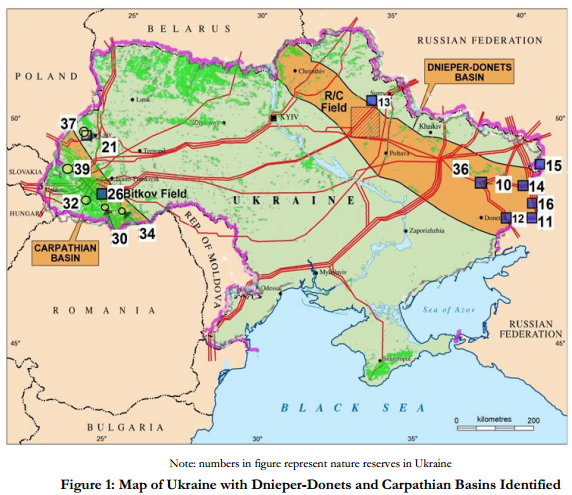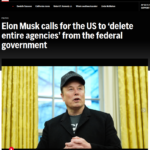The protesters in Ukraine have succeeded in ejecting Yanukovych from Kyiv (Kiev), with protesters taking control of the government buildings and the Parliament voting unanimously to remove Yanukovych from power. At the same time he has fled to Russia-friendly eastern half of the country, Kharkiv, where an assembly of regional political bosses have voted to reject the events in Kyiv and remain loyal to Yanukovych. In short this may turn into a civil war between the eastern and western halves of Ukraine. But, this blog being more about clean energy, clean transportation, what does it have to do with the politics of an Eastern European country?
As I wrote the other day, the unrest in the Ukraine is really about a geopolitical power struggle between the US, the European Union and Russia over control of natural gas to Europe, and which set of companies get to Frack Ukraine. I thought to follow up that post by looking for evidence of the US State Department’s Unconventional Gas Technical Engagement Program having any activity in the Ukraine.
That organization was launched by the Obama Administration, and is charged with exporting hydraulic fracturing technology around the world. What I’m finding in some research is several years of planning by powers-that-be to unleash a global wave of fracking, maintaining dominance of fossil fuels in “energy” supplies. Ukraine, Romania, which I’ve been covering recently, and several other countries are simply pawns in the global power chessboard.
The map of this game is directly related to the presence of shale formations from which shale gas can be extracted.

Here’s the map as it stands for Ukraine. Two formations, one in the west, the other in the east. It happens to correspond to the divide in Ukraine, where the western portion is more attuned to Europe where the eastern portion is more attuned to Russia. Also note that to Russians, the early formation of Russian identity happened in the territory now known as Ukraine.
To make this divide even clearer, here’s a sidebar from the source document, Ukraine Shale Gas: Environmental and Regulatory Assessment![]() , naming cities central to those regions.
, naming cities central to those regions.
Kharkiv? That’s the city to which Yanukovych fled and in which a power base of loyalists is being formed. It’s located in Eastern Ukraine.
Lviv? They freed themselves from Yanukovych’s rule months ago, according to the NY Times (A Ukraine City Spins Beyond the Government’s Reach![]() ), ruling itself without oversight by the central government. Further, a key event yesterday was the defection of a platoon of police officers who joined the protesters (Fed up with violence, Ukrainian police commander switches sides – CNN.com
), ruling itself without oversight by the central government. Further, a key event yesterday was the defection of a platoon of police officers who joined the protesters (Fed up with violence, Ukrainian police commander switches sides – CNN.com![]() ). From where did those officers come? Lviv.
). From where did those officers come? Lviv.
Whether this was planned or not, the country is split between Lviv and Kharkiv, which happens to be the locations of relevant shale gas deposits.
For some interesting proof of US and European and Russian involvement in causing this revolution in Ukraine, Democracy Now had an interesting interview![]() with Stephen Cohen, professor emeritus of Russian studies and politics at New York University and Princeton University. What they went over is an intercepted phone call between US Diplomats essentially planning which of the opposition leaders were to be put into power, and going over the geopolitical struggle between West and East, and how Ukraine is a fulcrum in that struggle.
with Stephen Cohen, professor emeritus of Russian studies and politics at New York University and Princeton University. What they went over is an intercepted phone call between US Diplomats essentially planning which of the opposition leaders were to be put into power, and going over the geopolitical struggle between West and East, and how Ukraine is a fulcrum in that struggle.
Another interesting read is a report from the US Senate Committee on Foreign Relations, dated December 12, 2012, titled ENERGY AND SECURITY FROM THE CASPIAN TO EUROPE. I don’t have a link, but google that phrase and it’ll come up. John Kerry was at the time Chairman of the committee, and is of course now head of the US State Department, hence is in charge of the US efforts to export hydraulic fracturing technology around the world as noted earlier. The paper is a summary of geopolitical concerns revolving around oil and gas supplies in the area of Azerbaijan and other central Asia countries bordering the Caspian Sea.
The goal of the document is discussing ways those resources can be brought to Europe and elsewhere without it crossing Russian territory. They’re building pipeline(s) across the Caspian Sea into Turkey in order to do so, making Turkey a key ally to NATO and the European Union.
The pipeline will also allow Iraqi gas to make it to Europe, that is if the Iraqi’s can settle issues about distribution of the wealth.
According to the report, several countries in Eastern Europe are saddled with importing 60% or more of Natural Gas from Russia. The Caspian pipeline will allow those countries to be supplied by different remote countries than Russia. Further it discusses how the US natural gas boom (thanks to Fracking) is letting the US supply LNG to Europe, freeing them from dependency on Russia.
The overthrow of a Russian-backed government in Ukraine through a a popular upraising is extremely historically significant. However, we see that it’s just one aspect of a larger political struggle between Russia and Europe and the US. Despite President Obama’s assertion otherwise, Ukraine is just a square on a global chessboard.
- The USA should delete Musk from power, Instead of deleting whole agencies as he demands - February 14, 2025
- Elon Musk, fiduciary duties, his six companies PLUS his political activities - February 10, 2025
- Is there enough Grid Capacity for Hydrogen Fuel Cell or Battery Electric cars? - April 23, 2023
- Is Tesla finagling to grab federal NEVI dollars for Supercharger network? - November 15, 2022
- Tesla announces the North American Charging Standard charging connector - November 11, 2022
- Lightning Motorcycles adopts Silicon battery, 5 minute charge time gives 135 miles range - November 9, 2022
- Tesla Autopilot under US Dept of Transportation scrutiny - June 13, 2022
- Spectacular CNG bus fire misrepresented as EV bus fire - April 21, 2022
- Moldova, Ukraine, Georgia, Russia, and the European Energy Crisis - December 21, 2021
- Li-Bridge leading the USA across lithium battery chasm - October 29, 2021


















Pingback: Ukraine caught in fracking-fueled tug-of-war between US and Russia, Europe’s natural gas supply at risk – The Long Tail Pipe